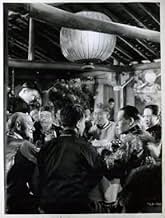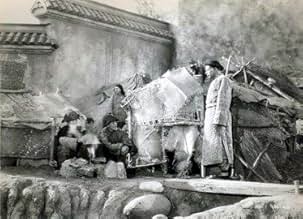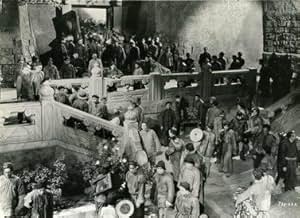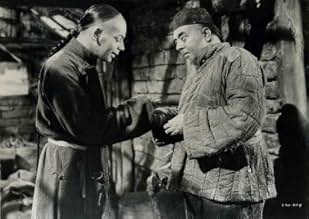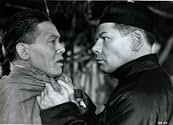Adicionar um enredo no seu idiomaAlthough married Chinese farmers Wang and O-Lan initially experience success, their lives are complicated by declining fortunes and lean times, as well as the arrival of the beautiful young ... Ler tudoAlthough married Chinese farmers Wang and O-Lan initially experience success, their lives are complicated by declining fortunes and lean times, as well as the arrival of the beautiful young Lotus.Although married Chinese farmers Wang and O-Lan initially experience success, their lives are complicated by declining fortunes and lean times, as well as the arrival of the beautiful young Lotus.
- Ganhou 2 Oscars
- 7 vitórias e 3 indicações no total
- Revolutionary Army Captain
- (não creditado)
- Man
- (não creditado)
- Teahouse Dancer
- (não creditado)
- Chinese Girl
- (não creditado)
Avaliações em destaque
From the very beginning of the picture, right after the lion's roar, we see the poignant tribute to Irving Thalberg, and we know that we are embarking on an important viewing experience. The scope of the story is very wide, and the filmmakers are up for the task. I was always struck by the abruptness of the final scene, but its power and beauty form an excellent example of the art achieved within the often cynical Hollywood film factory. And Lotus - the strangeness of her, and her dance, contrasted with the goodness of O-lan!
Aside from the oft-mentioned attributes of acting, photography and special effects, a major element in 'The Good Earth' is the score. Herbert Stothart may not be in the ranks of Hollywood's 'mighty handful' (Alfred Newman, Steiner, Tiomkin, Waxman, Herrmann), but his 'MGM-sound' scores regularly deliver the goods. True, Stothart had no hesitation in applying the syrup at first opportunity (one can imagine Louis B. Mayer positively ordering it), but in this picture, syrup gives way to sympathy. One of the pleasures of Hollywood's Golden Age films is that all the elements of a given film support each other, and great scores support not only the characters, but the entire film. Stothart's score is so sympathetic and so sincere, from the Main Title all the way through, and it enhances the story and the performances so naturally and at times transparently, that it must be considered a classic score. No great 'tunes' specifically, but plenty of effective mood, atmosphere and unabashed emotion. Many of today's audiences may find little to enjoy in such a combination, or they may be embarrassed by it, but I revel in it, as cinema such as this, which is delivered with such heart and good will is, especially in these times, nothing short of a gift.
The issue of non-Chinese playing Chinese characters has already been discussed on these pages, but I can only add: please, viewers, consider the film within the era that it was produced. The same kind of incongruity still happens today, perhaps not so much racially, but certainly culturally: Brad Pitt in 'Seven Years in Tibet', Keanu Reeves in 'Little Buddha', and other Americans getting plum roles in British-originated stories that become Hollywoodized, etc. When making 'Bhowani Junction', George Cukor considered using Indian actors, but vetoed any candidates in favor of familiar Hollywood faces. Never mind that in the 50s, as today, India had a huge film industry. It's just that those actors didn't fit into the Hollywood scheme of things. That speaks of box office more than political incorrectness. There is no doubt that fine actors like Philip Ahn should have gotten lead roles in pictures like 'The Good Earth', but at least we can enjoy them in supporting roles which carry a lot of weight in their own right. As time goes on, the context of past eras fades, while the films themselves, the really good ones, live on. There's plenty of opportunity for revisionist theses about issues like racial inequality in 1930s Hollywood, but for 138 minutes, it is compelling and moving to absorb onesself in the story and the atmosphere of 'The Good Earth'.
The story begins on the wedding day of Wang Lung (Paul Muni), a kind and gentle farmer. His wife, O-Lan (Luise Rainer), bears his sons and quietly encourages him to pursue his dreams, no matter what sacrifices they entail from her. The family lives through a famine and finally achieves prosperity and success. However, with success comes greed and corruption, and soon Wang is buying large plots of land and the Great Hall at which O-Lan was a servant. Eventually, he takes a second wife and breaks ties with all who were once close to him. It takes a tragedy for him to see the error of his ways.
All the while O-Lan stands behind him, supporting every decision he makes in her own tranquil way. Rainer's Oscar winning portrayal, like O-Lan herself, is the glue that holds the story together. Muni, often prone to hamminess in his work, shows restraint here and contributes a beautiful, multifaceted performance. The cinematography, which also received an Oscar, is excellent, as are the special effects. A sequence which involves locusts, invading the crops by the million, is nothing short of unforgettable. It is storytelling in the grandest sense of the word, with strong characterizations, high production values, and an engrossing story which more than justifies `The Good Earth's status as a classic.
I was particularly impressed by the camera work and the use of crowd scenes, especially during the sacking of the palace where O-Lan was once a slave. The graphic and grim atmosphere of the firing squad and the drought made this an epic quite unlike others of the same time where it was all glitz and glitter. I watched this film from beginning to end enthralled. I can't say the same for the "epics" of today.
A wonderful story by Pearl Buck, Great direction by Sidney Franklin and Victor Fleming [uncredited], very good acting headed by Paul Muni, great cinematography by Karl Freund, and special effects 20 years ahead of their time make this a classic.
However as good as those elements to this film are the reason The Good Earth is one of the 100 greatest films of all time is O-Lan. O-Lan, O-Faithful O-Lan. How you linger in my memory. One of my two favorite female character-performances in film history. The other is Scarlett O'Hara. Two peas in a pod? No, more like night and day. Both beautiful in their own way. It amazes me that these two character-performances came from films directed by Victor Fleming within two years of each other. Louise Rainer as O-Lan gives a performance as subtle and subdued as the character she plays. While Vivien Leighs performance is as perky and over the top as the character she plays. O-Lan is discreet and selfless. Scarlett is brash and self-absorbed. O-What a double feature Gone With the Wind and The Good Earth would make. O-Lan and Scarlett. Ying and Yang.
If you are a "liberated woman" than The Good Earth may not be for you. But as for me, O-Lan is the salt of the good earth.
Luise Rainer was the beautiful star who had won the Best Actress Oscar the year before for her small role (and what a waste of an oscar) in "The Great Zigfield". It really didn't show what, if any, talent she had other than her exotic beauty. But in "Good Earth" she shows that she can really act! Her beauty was erased and she had no great costumes either. People say that she didn't show any real emotions in this film. Like hell. Her character Olan is a shy and timid woman, with inner strength. She is quiet during parts of the film with only her eyes and body to convey her emotions. Example: those scenes during the fall of the city and when looters were being shot. If you people are saying that she doesn't act well in this film, you are NOT looking!
Paul Muni shows that he can act as well. His character is not a likeable one to me. He never sees her for what she is, until the very end of the story. A sweet loving and dedicated wife and mother, with her own special beauty. The greatest one of all, the beauty from within, like a pearl.
If you get a chance to see this film, watch it. You will see one of the best films that the golden age of Hollywood created.
Você sabia?
- CuriosidadesSpecial effects experts were unable to produce an authentic-looking locust plague. Just as they were about to abandon the scene, they received word that a real locust plague was taking place several states away. A camera crew was rushed to the scene to capture it on film.
- Erros de gravação(at around 2h 5 mins) Wang Lung is walking through the locust storm in his wheat field. He picks up a few men who have fallen down into the thick pile of locusts. In frustration, Wang shouts "I said save the wheat! Save it!" At this moment, a man dressed in 1937-era American clothing walks across the scene from left to right, at the top third of the screen. He is wearing a white hat and appears to be smoking a cigarette or cigar held in his left hand.
- Citações
Wang Lung: [must sell his land to feed his family but the buyers take advantage of him] Thieves! Thieves! And well you know I must sell.
O-Lan: No! Not the land. We'll not sell the land. We'll keep it. We'll go south and when we return, we'll still have the land.
Uncle: But I've arranged it. I brought these men here. You MUST sell!
O-Lan: Is it your land? Did you buy it bit by bit? The land is our life... and it's better to go south... or die walking... than to give it to you for nothing.
- Cenas durante ou pós-créditosIntroduction played with opening credits: The soul of great nation is expressed in the life of its humblest people. In this simple story of a Chinese farmer may be found something of a the soul of China - its humility, its courage, its deep heritage from the past and its vast promise for the future.
- ConexõesEdited into A Estirpe do Dragão (1944)
Principais escolhas
Detalhes
- Data de lançamento
- País de origem
- Central de atendimento oficial
- Idioma
- Também conhecido como
- A Terra dos Deuses
- Locações de filme
- Cedar City, Utah, EUA(backgrounds for locust sequence)
- Empresa de produção
- Consulte mais créditos da empresa na IMDbPro
Bilheteria
- Orçamento
- US$ 2.800.000 (estimativa)
- Tempo de duração2 horas 18 minutos
- Proporção
- 1.37 : 1
Contribua para esta página




